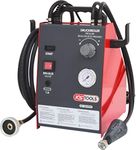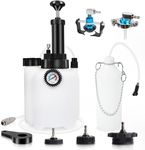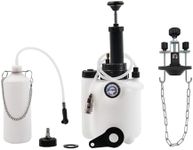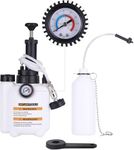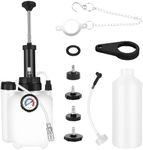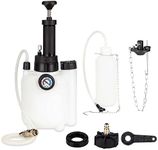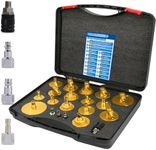Buying Guide for the Best Brake Bleeders
Choosing the right brake bleeder is crucial for maintaining your vehicle's braking system effectively. A brake bleeder is a tool used to remove air bubbles from the brake lines, ensuring that your brakes function properly. When selecting a brake bleeder, consider the type of vehicle you have, the frequency of use, and your level of experience with vehicle maintenance. Understanding the key specifications will help you make an informed decision that suits your needs.Type of Brake BleederBrake bleeders come in various types, including manual, vacuum, and pressure bleeders. Manual bleeders require physical effort to pump and are suitable for occasional use or for those who prefer a hands-on approach. Vacuum bleeders use suction to remove air and are ideal for those who want a quicker, less labor-intensive process. Pressure bleeders are more advanced and are often used by professionals for their efficiency and ability to handle larger volumes. Choose a type based on how often you plan to use it and your comfort level with vehicle maintenance.
CompatibilityCompatibility refers to whether the brake bleeder can be used with your specific vehicle's brake system. Some bleeders are universal, while others are designed for specific makes and models. It's important to ensure that the bleeder you choose is compatible with your vehicle to avoid any issues during the bleeding process. Check the product specifications or consult with a professional if you're unsure about compatibility.
CapacityThe capacity of a brake bleeder indicates how much fluid it can hold. Smaller capacity bleeders are suitable for personal use or smaller vehicles, while larger capacity bleeders are better for professional use or larger vehicles. Consider the size of your vehicle's brake system and how much fluid you typically need to handle when choosing the capacity. A larger capacity can be more convenient if you plan to bleed brakes frequently or work on multiple vehicles.
Ease of UseEase of use is an important factor, especially for those who are new to using brake bleeders. Some models come with features like one-person operation, clear instructions, and ergonomic designs that make the process simpler and more efficient. If you're a beginner, look for a brake bleeder that is user-friendly and doesn't require extensive setup or technical knowledge. This will make the bleeding process smoother and more manageable.
Build QualityThe build quality of a brake bleeder affects its durability and longevity. High-quality materials like metal or reinforced plastic can withstand repeated use and exposure to brake fluid without degrading. If you plan to use the bleeder frequently or in a professional setting, investing in a well-built model can save you money in the long run. Consider how often you'll use the tool and the conditions it will be exposed to when evaluating build quality.
